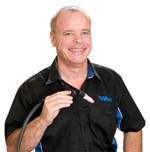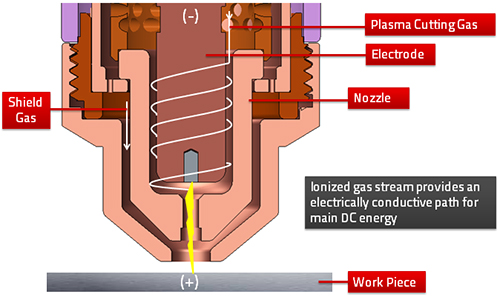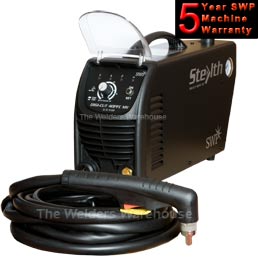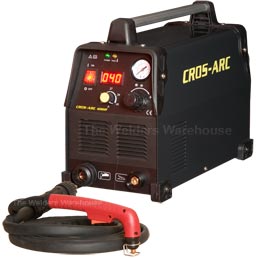01908 6998020845 899 4400 | 01908 699802Tel 01908 699802
Plasma Cutters


Plasma Cutters are a fantastic tool. It is, however, important to understand the different types of arc ignition and to be realistic about performance!
I’ve also produced a Video about choosing a Plasma Cutter
How Plasma Cutters Work
Plasma Cutters use compressed air and an electric arc to cut metal.
You can cut just about any metal with a Plasma Cutter, including Mild Steel, Stainless Steel and Aluminium.
Plasma Cutters work by forcing compressed air into a chamber that contains a Plasma Electrode and a Plasma Cutting Tip. As the compressed air is forced into the chamber an electric arc is struck between the Plasma Electrode and Plasma Cutting tip.
This arc “Plasmarises” the compressed air, making it electrically conductive.
This electrically conductive air then escapes the pressurised chamber via a small hole in the Plasma Cutting tip, taking the energy of the arc with it. The heat of the Plasma Arc melts the metal to be cut, while the force of the compressed air blows it away.

Because the stream of plasmarised air is very narrow and the melted metal is blown away, the Plasma Cutter introduces very little heat into the job, thus there is little, or no, distortion of the job.
Plasma Cutters also offers a big advantage over more traditional cutting methods in that it operates from only one side and can easily cut any shape, even where there is a second panel behind that is to be left intact.
Plasma Arc Ignition
There are two basic forms of Plasma Arc Ignition, High Frequency and Contact Striking.
High Frequency (HF) Arc Ignition
Here, a brief High Frequency arc is used to jump the gap between the Plasma Electrode and Tip. This allows the main arc to form across the HF arc and cutting to start.
Contact Arc Ignition
Here, the Torch Head keeps the Plasma Electrode and Tip in contact with each other, creating a dead short.
When the Torch Trigger is pressed to start Cutting, the machine delivers a small amount of power, at the same time, compressed air is used by a pnuematic piston to pull the Plasma Electrode and Tip apart.
As this happens, the machine delivers full power to start the arc.
This process is much the same as starting an old fashioned Arc Welding Rod, where the rod is touched down and lifted off to start welding!
HF or Contact Arc Start?
Which is the best method of Arc starting depends a lot on how you use a Plasma Cutter.
High Frequency is better for automated (CNC) Plasma Cutting because the often frequent stopping and starting of the Plasma Arc will wear the Torch Head Piston of a Contact Start. HF is also a little faster, so again, better suited to the rapid stop/start cutting of a CNC application.
High Frequency Start does however require additional electronic circuitry. This can be expensive to replace if it fails outside of warranty. There is also a theoretical possibility that HF could cause problems with nearby sensitive electonic devices, or medical items (Pacemakers for example).
Contact Arc Starting is better suited to Hand Plasma Cutting. It’s a simpler system, so there’s less to go wrong. The lack of High Frequency also means Contact Start Plasma Cutters are less likely to cause problems with other electronic or medical devices.
Choosing the right Plasma Cutters
Plasma Cutters are generally selected by cut performance, that is to say how thick they will cut.
Plasma Cutter cut performance is quoted for mild steel. Stainless Steel and Aluminium require more power, so generally, cut performance will be less for these materials.
Typically, a Plasma Cutter that is quoted as having a max cut capacity of 6mm Mild Steel, will cut a max thickness of 5mm Stainless Steel and 3.0mm Aluminium, or around 10% and 50% less than mild steel.
Care has to be taken with manufacturers claims on Plasma Cutters cut capacity; more honest suppliers will quote a “max or Genuine Cut Capacity” and a “Max Sever”.
The “Max or Genuine Cut Capacity”, lets say 6mm, means the Plasma Cutter will cut up to 6mm mild steel, cleanly and at a speed of at least 250mm (10″) per minute.
“Max Sever”, lets say 10mm, is the absolute maximum that the Plasma Cutter will achieve on Mild Steel. However, expect a poor quality cut and VERY slow speed.
Unfortunately, some Plasma Cutter suppliers will say “cuts up to 10mm steel” when the thickness they quote is in fact the Max Sever! It’s “Buyer Beware” I’m afraid!
Obviously, the thinner the metal, the quicker a Plasma Cutter will cut, at a given output power.
As a rule of thumb, I always suggest customers consider a Plasma Cutter with a cut capacity at least 30% greater than they think they will need. That way there’s always spare capacity if required and good cut speed on the planned work.
Plasma Cutters Power Input
Input power requirement is another important factor to consider.
Generally speaking, a Plasma Cutter that has an output of up to 30amps will normally run fine off a 13amp Fused Plug.
However, the most common starting size for a Plasma Cutter is 40amps output! These machines normally require a 16amp power supply to operate at the maximum output.
That having been said, our 40amp Plasma Cutters have an output range that is typically 20-40amps. So can be used at an output that is within a 13amp fuse. In fact our own tests have shown that the Cros-Arc Plasma Cutter works at full power off a 13amp supply, if a Slow Blow (‘T’ type) fuse is used and the arc is not stop/started too quickly.
Conclusions
Plasma Cutters are a great tool, but it’s worth carefully considering your needs before making a purchase.
I hope you found this blog article about Plasma Cutters useful.
Please let me know what you thought by leaving a comment.
Don’t worry, your email address won’t be added to a database or shared and you won’t receive any unsolicited email.
Cheers
Graham




Mild sound cutter machine which produces almost no sound is there any to cut 8 to 16mm iron rod
U may call me over 7076485763
Or mail me or WhatsApp me
Please suggest how can I cuy 8to 16 mm iron rod soundlessly
With regards
Arjun Biswas
Hi Arjun
Plasma Cutters are fairly quite, but not silent! I regret I don’t know of a way of cutting 8mm – 16mm Iron Rod without sound, apart from a Hacksaw! But if you have lots to do……..
Cheers
Graham
Hi. Thank you for descriptions. I need information abot nozell, plasma tip materil.
Hi Hojjat
I regret I cannot provide such information in a blog comment. Please go to our main website Contact Page and ask a question there.
Regards Graham
It’s not often I come across some great advice like this about the max sever, there are so many manufacturers with big claims out there regarding cut thickness. It’s sometimes hard to spot but if you are dealing with the manufacturer directly you can usually email them to check. Generally anything above 30amps we fit industrial 16 amp plugs to as we prefer no bottleneck in the power supply.
We recently acquired a budget plasma to cut out some of our homeware designs and were surprised by the accuracy of the cut. However where most budget machines lack is the torch quality and sometimes they don’t adhere to the type of standard that’s embossed in the side so it makes finding consumables often difficult.
Thanks for the comment, glad you found the information useful.
Budget Plasma Cutters are a gamble, in a number of ways!
Our Plasma Cutters all use Torches that are made by, or compatible with, Trafimet.
Trafimet are Italian, excellent quality, and their spares are probably the most widely available in the UK and Europe.
Cheers Graham